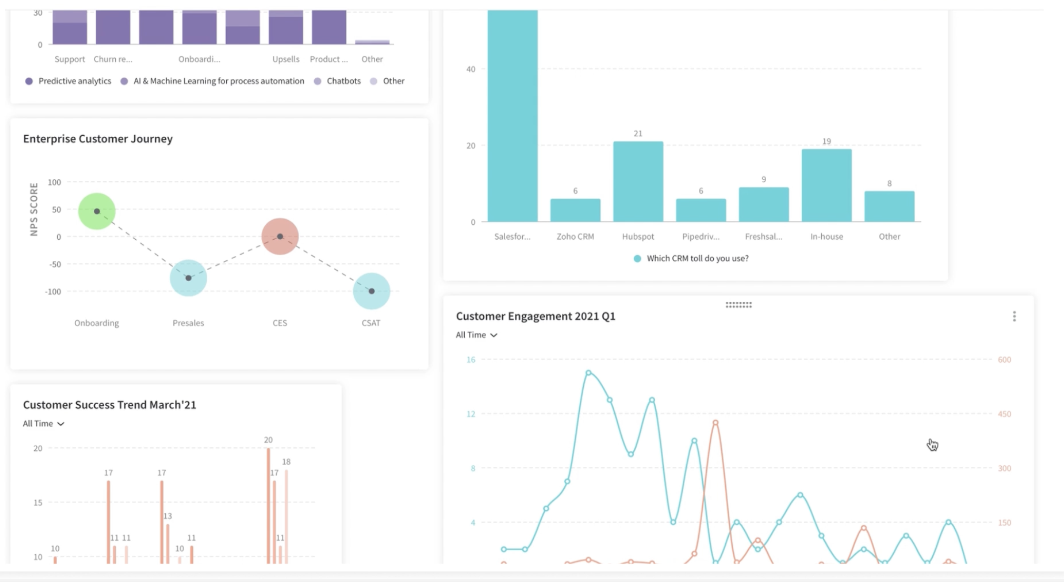Customer Experience
Customer Experience Roadmap: A 5-Step Comprehensive Guide
Article written by Kate Williams
Content Marketer at SurveySparrow
11 min read
19 September 2025

When it comes to business competition, offering an exceptional customer experience (CX) is an absolute must. An outstanding CX is the heart of customer retention and a key strategy for customer acquisition.
To ensure your business consistently delivers an impressive CX, a well-structured plan, or a customer experience roadmap, is vital.
This article aims to walk you through a step-by-step process of building a customer experience roadmap, setting you on a course towards establishing an immersive customer experience that will keep your patrons returning for more.
What is the Customer Experience Roadmap?
A customer experience roadmap is a strategic plan that outlines the steps a business will take to enhance its customer experience. It typically includes identifying customer touchpoints, analyzing current customer interactions, setting clear objectives for improvement, and implementing specific initiatives or technologies to reach these goals.
This roadmap is designed to guide a company in creating a more satisfying and engaging customer experience, ultimately leading to increased customer satisfaction, loyalty, and business success.
Why Build a Customer Experience Roadmap?
Constructing a comprehensive roadmap allows organizations to channel their resources, time, and endeavors toward the aspects of CX that are of utmost importance to their customers. Thus, it facilitates a visual representation of your CX strategy, helps identify potential gaps, and uncovers avenues for improvements.
Moreover, the roadmap ensures that each department within the organization aligns with the overarching CX goals, hence, creating a uniform experience across all customer interactions.
To develop an immersive CX, a well-rounded, engaging, and satisfactory customer interaction that meets and often surpasses the expectations of the customer. Your initial focus should be on a strategic plan or a roadmap. A customer experience roadmap is a comprehensive guide that details the sequential steps your business intends to take to enhance the overall CX.
It sketches out the strategies for understanding the needs, desires, and expectations of your customers, and illustrates how your organization plans to meet these most effectively. In essence, it’s the blueprint for constructing an immersive customer experience.
Creating a Customer Experience Roadmap: A 5-Step Easy Guide
Designing an effective roadmap necessitates meticulous planning, acute insights, and a profound understanding of your customers.
Here are five clear steps to guide you in this significant process:
a. Acquainting Yourself with Your Customers
The preliminary step in constructing a roadmap is gaining a thorough understanding of your customers. Gather as much data as you can about your customers, including their demographic details, behaviors, preferences, pain points, and expectations.
Leverage tools such as surveys, interviews, focus groups, and data analytics to amass this information. Keep in mind that the more data you have about your customers, the better prepared you’ll be to cater to their needs.
b. Delving Deeper into Customer Understanding
After gathering sufficient data, it’s time to analyze it and discern meaningful insights. Look for patterns, trends, and commonalities among your customer base. Also, try to identify their needs and wants, their likes and dislikes, and the key factors that influence their purchasing decisions.
Also, this will assist you in segmenting your customers into specific groups, enabling you to customize your services and products to cater to their distinct needs.
c. Plotting Out Customer Journey Maps
A customer journey map is a graphical illustration of every interaction your customers have with your business. It provides a unique perspective into how customers engage with your brand at each touchpoint.
Thus, it enables you to pinpoint areas where the customer experience might be lacking and identify opportunities to augment it.
SurveySparrow assists you in easily tracking where your customers are in the journey and aids you in the conversion. We help you visualize the customer experience across multiple touchpoints on the customer journey chart.

Explore Deeper Customer Insights with SurveySparrow
A personalized walkthrough by our experts. No strings attached!

Ensuring we are always in touch with customers providing a memorable experience. You can track unique customer journeys with the executive dashboard. Put feedback and make evaluation easy with an end-to-end journey chart.
Eager to know how? Try out our 14-day free trial now. Grab it soon!
d. Charting Your CX Enhancement Goals
Once you have a solid understanding of your customers and their journey, it’s time to define your CX improvement objectives. These goals should be in line with your business aims and be designed to enhance the overall customer experience.
Thus, they could be associated with improving customer service, streamlining the purchasing process, enhancing product quality, or developing a more user-friendly website. Additionally, incorporating an outbound call center solution could significantly bolster your efforts to deliver personalized and efficient customer interactions.
Remember, your goals should be specific, measurable, achievable, relevant, and time-bound (SMART).
e. Establishing Milestones and Benchmarks
Finally, determine milestones and benchmarks to track your progress toward your CX improvement objectives. These benchmarks will enable you to evaluate whether your strategies are effective and if you’re moving towards your goals. Also, regularly review and adjust your roadmap as needed to ensure it remains aligned with your business objectives and customer expectations.
Employing CMS for a Remarkable Immersive Customer Experience
A Customer Management System (CMS) can prove to be a potent tool in fostering an immersive CX. It can aid in centralizing and managing customer data, tracking customer interactions, and delivering personalized experiences.
An efficient CMS will empower you to execute your customer experience roadmap successfully. Thus, ensuring that you consistently deliver an outstanding CX at each touchpoint.
Result Tracking for a Customer Experience Roadmap
Tracking results from this roadmap involves a systematic approach to evaluate the effectiveness and impact of the strategies and initiatives outlined in the roadmap. Here’s a detailed process to do so:
Define Key Performance Indicators (KPIs):
Identify specific, measurable KPIs that align with the objectives of your roadmap. These could include metrics like Net Promoter Score (NPS), Customer Satisfaction Score (CSAT), Customer Effort Score (CES), retention rates, or conversion rates. SurveySparrow helps you measure customer loyalty and satisfaction using all these modules.
NPS:
Net Promoter Score or NPS is a simple metric that yields powerful insights into two important aspects of a business — loyalty & brand advocacy. NPS is measured by asking customers/employees the likelihood of recommending a product/service to family or a friend. The respondents rate their score on an opinion scale of 0-10 with 0 being very unlikely and ten being extremely likely. Based on the score, they fall into three categories- Promoters, Passives, and Detractors
Net Promoter Score is defined as, “A customer loyalty metric that analyzes customer sentiments in order to understand their inclination towards recommending a company to a friend or colleague.”
CSAT:
Companies must know if what they provide meets the expectations of the customers. If the gap between what they offer and what customers require is far, the brand is bound to stumble and tumble.
That’s where the significance of CSAT surveys comes to the fore. It’s one of the most sought-after ways to know how customers feel about an interaction they had with you, a purchase they made, or the experience they had with your brand.
Our customer satisfaction survey software can quickly help you collect all the data you need to know about customer pulse in no time.
CES:
Customer Effort Score is one of the most popular customer satisfaction survey methodologies used to measure how satisfied your customers are with your products/services and offering. What does Customer Effort Score measure? It measures the ease of experience for a customer with a company. However, Customer Effort Score (CES) takes a slightly different approach where it asks the effort a customer had to take in interactions with the brand.
“CES is 1.8x more predictive of customer loyalty than customer satisfaction (CSAT) measures, plus it is two times more predictive than Net Promoter Score (NPS).”
-Gartner
Establish Baselines:
Before implementing any changes, it’s important to have a clear understanding of your current performance. Measure your KPIs to establish baselines, allowing you to see the improvement over time.
Regular Monitoring:
Continuously track your KPIs at regular intervals. This could be weekly, monthly, or quarterly, depending on the nature of your initiatives. Use tools like customer feedback platforms, analytics software, and CRM systems to gather data.
Feedback Loops:
Implement mechanisms to gather direct feedback from customers. Surveys, focus groups, and customer interviews can provide qualitative insights that complement your quantitative data.
Data Analysis:
Analyze the data to identify trends, patterns, and areas of improvement. Look for correlations between the initiatives you’ve implemented and changes in your KPIs.
Report and Communicate:
Regularly report the findings to stakeholders. Use visual tools like dashboards or presentations to make the data accessible and understandable. Communication should highlight successes, challenges, and areas for improvement.
Iterate and Optimize:
Use the insights from your tracking to make informed decisions. Adjust your CX initiatives as needed to optimize performance and enhance customer experience.
Long-Term Review:
On a yearly or bi-yearly basis, review the overall impact of your roadmap. Assess whether long-term goals are being met and if the roadmap needs major revisions to align with changing customer expectations or business objectives.
Competitive Benchmarking:
Compare your results with industry benchmarks or competitors. This can provide context for your performance and highlight areas where you may need to focus more attention.
Integration with Overall Business Strategy:
Ensure that the results and insights from your CX tracking are integrated into the broader business strategy. This alignment ensures that customer experience remains a central focus in all business decisions.
Wrapping Up
Developing a customer experience roadmap is a strategic process that can significantly enhance your ability to provide an immersive CX.
Understand your customers, map their journeys, set improvement goals, and monitor your progress. By this, you can construct a roadmap that aligns with your business objectives and meets your customers’ expectations.
This Roadmap isn’t a static document—it should continually evolve with your business and customers. It’s essential to regularly revisit and update your roadmap to ensure it remains current and effective.
Remember, the ultimate goal is to establish an immersive CX that delights your customers and distinguishes you in the competitive landscape.
FAQs
1. Why is a CX Roadmap crucial for businesses today?
It helps businesses systematically improve customer interactions, leading to increased satisfaction, loyalty, and competitive advantage.
2. How does an immersive customer experience differ from regular customer service?
An immersive CX encompasses all aspects of customer interaction, creating a holistic, personalized experience beyond just providing service.
3. Can small and medium-sized enterprises benefit from a CX Roadmap?
Yes, businesses of all sizes can benefit from this roadmap as it helps align customer interactions with business goals, regardless of the company’s size.
4. How often should a business update its CX Roadmap?
Regular updates, at least annually or biannually, are recommended to ensure the roadmap remains aligned with evolving customer needs and business goals.
5. How do you measure the success of a CX Roadmap?
Success is measured through KPIs like Net Promoter Score, Customer Satisfaction Score, retention rates, and qualitative feedback from customers.
6. What challenges might a company face when implementing a CX Roadmap?
Challenges include aligning cross-departmental efforts, budget constraints, adapting to customer behavior changes, and integrating new technologies.
7. Can a CX Roadmap impact employee experience and engagement?
Yes, a well-implemented roadmap can positively affect employee engagement by providing clear goals and improving internal processes.
8. How does technology influence the execution of this Roadmap?
Technology, like CRM systems and data analytics tools, plays a key role in understanding customer behaviors and personalizing experiences.
9. How can businesses ensure consistency in customer experience across all channels?
By implementing integrated strategies that address customer interactions uniformly across all touchpoints, both online and offline.
10. What are common mistakes to avoid when developing a CX Roadmap?
Common mistakes include not sufficiently understanding customer needs, lack of cross-departmental collaboration, and failing to set measurable goals.
11. How can customer journey mapping benefit this Roadmap?
It helps in visualizing the customer’s path through different touchpoints, identifying areas for improvement, and enhancing the overall experience.
12. How should a business handle negative feedback or failures in its CX Roadmap?
By viewing them as opportunities for learning and improvement, addressing the underlying issues, and continuously refining the CX strategy.

Make your customers feel heard. Turn feedback into loyalty with SurveySparrow's CX platform.
Kate Williams
Related Articles

Customer Experience
Payment Experience: What is it & How to Improve it?
12 MINUTES
3 March 2024

Customer Experience
7 Effective Ways to Build an Awesome Customer-centric Culture
12 MINUTES
8 March 2020

Customer Experience
What is Customer Experience Analysis: A Comprehensive Guide
13 MINUTES
7 March 2023

Customer Experience
6 Metrics Chief Customer Officers Care About & How to Impact Them
15 MINUTES
17 March 2021
